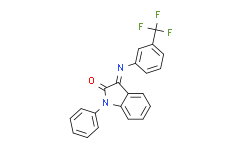| 中文名称: | HT-2157 一键复制产品信息 | ||||
|---|---|---|---|---|---|
| 英文名称: | HT-2157 | ||||
| 别名: | 1-phenyl-3-[3-(trifluoromethyl)phenyl]iminoindol-2-one | ||||
| CAS No: | 303149-14-6 | 分子式: | C21H13F3N2O | 分子量: | 366.34 |
| CAS No: | 303149-14-6 | ||||
| 分子式: | C21H13F3N2O | ||||
| 分子量: | 366.34 | ||||
基本信息
|
产品编号: |
H10756 |
||||
|
产品名称: |
HT-2157 |
||||
|
CAS: |
303149-14-6 |
储存条件 |
粉末 |
-20℃ |
四年 |
|
分子式: |
溶于液体 |
-80℃(氮气储存) |
6个月 |
||
|
分子量: |
366.34 |
-20℃(氮气储存) |
1个月 |
||
|
化学名: |
2H-Indol-2-one,1,3-dihydro-1-phenyl-3-((3-(trifluoromethyl)phenyl)imino)-,(3E)- |
||||
|
Solubility (25°C): |
|||||
|
体外:
|
DMSO |
|
|||
|
Ethanol |
'mg/mL |
||||
|
Water |
|
||||
|
体内(现配现用): |
|
||||
|
<1mg/ml表示微溶或不溶。 |
|||||
|
普西唐提供的所有化合物浓度为内部测试所得,实际溶液度可能与公布值有所偏差,属于正常的批间细微差异现象。 |
|||||
|
请根据产品在不同溶剂中的溶解度选择合适的溶剂配制储备液;⼀旦配成溶液,请分装保存,避免反复冻融造成的产品失效。 |
|||||
制备储备液
|
浓度
溶液体积 质量 |
1mg |
5mg |
10mg |
|
1mM |
2.7297mL |
13.6485mL |
27.2970mL |
|
5mM |
0.5459mL |
2.7297mL |
5.4594mL |
|
10mM |
0.2730mL |
1.3649mL |
2.7297mL |
生物活性
|
产品描述 |
一种选择性的高亲和力甘丙肽-3 受体 (Gal3) 竞争性拮抗剂。 |
|
靶点 |
Galanin-3 receptor |
|
体外研究 |
HT-2157 (SNAP 37889) binds with high affinity to membranes from transiently transfected LMTK-cells expressing the human Gal3 receptor (Ki=17.44±0.01nM;n>100) and is highly selective for Gal3 over the Gal1 and Gal2 subtypes (Ki>10,000nM for each subtype;n=46 of each subtype).When tested for the antagonism of galanin-evoked inhibition of adenylyl cyclase,HT2157 (0.1-10μM) produces concentration-dependent rightward shifts of the concentration-effect curve to galanin. |
|
体内研究 |
The galanin-3 receptor antagonist,HT-2157 (SNAP 37889),reduces operant responding for ethanol in alcohol-preferring rats.The novel selective GALR3 antagonist,HT-2157,to reduce anxiety-like behaviour and voluntary ethanol consumption in the iP (alcohol-preferring) rat.Male iP rats treated with HT-2157 at a dose of 30mg/kg (i.p.) do not show altered locomotor activity or changes in anxiety-like behaviour in the elevated plus maze or light-dark paradigms.Treatment with HT-2157 (30mg/kg,i.p.) reduces operant responding for solutions containing ethanol,sucrose and saccharin.Collectively, results from the current study shows that HT-2157 (30mg/kg,i.p.) is effective in reducing operant responding for ethanol,independent of a sedative effect. |
推荐实验方法(仅供参考)
|
激酶实验: |
|
Binding affinities for HT-2157 (SNAP 37889) and SNAP 398299 at the human Gal1,Gal2,and Gal3 receptors are determined by using the 125I-galanin displacement assay.Additionally,is tested for binding in a broad cross-reactivity panel that included G-protein-coupled receptors,ion channels,enzymes,and transporters.The ability of HT-2157 to antagonize functional responses to galanin is examined in modified HEK-293 cells (PEAKrapid cells) transiently cotransfected with the Gal3 receptor and Gαz by measuring the inhibition of adenylyl cyclase activity. |
|
动物实验: |
|
|
Rats The effect of HT-2157 on locomotor activity is examined using adult male iP rats (n=12;418-467g).Locomotor activity is tested to ensure that any potential change in anxiety or ethanol consumption in subsequent tests is not due to any sedative property of the drug.Rats are habituated to the locomotor cells (26×26×40cm) for 60 minute sessions which are conducted daily for three consecutive days.To minimise the effect of habituation during the treatment phase,rats are divided into two even groups which received a single injection of either HT-2157 (30mg/kg,i.p.) or vehicle (1ml/kg i.p.) 30 min prior to being placed in the locomotor cells for a 60 minute session.The following day the treatments are reversed so that all rats received treatment with both the vehicle and SNAP 37889 compound.Movements in terms of number of moves,move time (s) and total distance travelled (cm),are recorded automatically using TruScan 2.0 software. |
|
本计算器可帮助您计算出特定溶液中溶质的质量、溶液浓度和体积之间的关系,公式为:
质量 (g) = 浓度 (mol/L) x 体积 (L) x 分子量 (g/mol)
摩尔浓度计算公式
用本工具协助配置特定浓度的溶液,使用的计算公式为:
开始浓度 x 开始体积 = 最终浓度 x 最终体积
稀释公式
稀释公式一般简略地表示为:C1V1 = C2V2 ( 输入 输出 )








